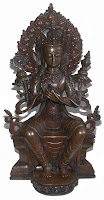 Maitreya [The future and fifth human-Buddha], The Compassionate OnePosture of hands [Mudra]: dharmacakra [turning the wheel of law]Symbol: kalasa [vase], cakra [wheel], and body color: yellow or whiteEmblem: naga pushpa [white flower with yellow center]
Maitreya [The future and fifth human-Buddha], The Compassionate OnePosture of hands [Mudra]: dharmacakra [turning the wheel of law]Symbol: kalasa [vase], cakra [wheel], and body color: yellow or whiteEmblem: naga pushpa [white flower with yellow center] Buddhist tradition divides the period between the death of Buddha and the manifestation of Maitreya in the actual universe into three divisions of time: I Period of 500 years, 'the turning of the Wheel of the first Law'. II Period of 1,000 years, period of deterioration of 'the law of images' [Sadharma pratirupaka]. III Period of 3000 years, 'the turning of the Wheel of the second Law', after which Maitreya will leave the Tushita heaven and come upon earth to 'establish the lost truths in all their purity.'
Maitreya is the only Bodhisattva, who is popular among all the sects Buddhism, i.e., the Hinayana, Mahayana, and the Vajrayana, and often his statues and paintings are found in all Buddhist shrines of northern and southern Buddhist.



Sakya-muni is supposed to have visited Maitreya in the Tushita heaven when he appointed him his successor, and many Buddhist sages [arhats] are believed to have had communion with him, transporting themselves by supernatural means to the Tushita heaven to seek enlightenment on various religious points. The great Asanga, one thousand years after the birth of Buddha Sakya-muni, ascended to the Tushita heaven, where Maitreya, initiated him, into the mystic doctrine of Tantra, which he grafted on to the Mahayana school in the beginning of the sixth century. Certain sects therefore look upon, Maitreya, as the founder of the Tantra school.
Although the cult of Maitreya was evolved before Indian King Asoka's time, his worship was not at its height until the fifth century AD, and there are many statues of him in the famous Gandhara sculptures of that period. He is represented either as Buddha or Boddhisattva. As Buddha he often with long hair drawn up in a knot on his head forming the ushnisha, his hands in dharmacakra mudra [turning the Wheel of the Law]; and as Boddhisattva he may be standing with his long hair hanging over his shoulders and his hands form 'argument' and 'charity' mudra [posture]
Tibetan Schools of Buddhism also worship Maitreya both as Buddha and Boddhisattva. As Buddha, he has short curly hairs, the ushnisha, urna, and long lobed ears. He wears monastic garment with crown and ornaments, and his hands are in dharmacakra mudra both holding lotuses stems with cakra [Wheel] in right and kalasa vase in left. He is seated with legs locked or sometime the legs, instead of locked, are pendent, and the feet may be unsupported.
We may find some minor difference in his iconographic representation among the various sects of Buddhism. The early Mongolian images of Maitreya are also generally standing, and hold in their hands forming 'argument' and 'charity' mudra, the stems of flowers called 'campa', which, however, in the bronzes often resembles the lotus flower.
In the bas-reliefs of the temple of Boro Boedoer, there are many representations of Maitreya, which date from the ninth century. In Java Indonesia, he is also found in statuary form, as for instance in the temple of Tjandi Mendut, where he is figured seated the leg pendent and the hands in the dharmacakra mudra.
In the ancient Gandhara sculptures, Maitreya was represented much larger than his assistants were. According to the Chinese traveler Hsuan Tsang, there is a statue of Maitreya at Dardu, north of the Punjab, in wood, which is one hundred feet high. It is said to have been created by artist whom Lohan Madhyantika caused, by magic, to mount three times to the Tushita heaven to contemplate the form of Maitreya before carving the statue.
The group of five Manushi Buddha, corresponding with Panca-Dhyani-Buddha and five meditative Bodhisattvas are mentioned as below.
1:KRAKUCHANDRA is a first Manushi Buddha, who is emanated from the first Dhyani Buddha Vairocana.
2: KANAKMUNI is considered as second Manushi Buddha, emanated from second Dhyani Buddha Akshobhya.
3:KASYAPA is considered as the third Manushi Buddha being emanated from third Dhyani Buddha Ratnasambhava.
4:SAKYA-MUNI is a forth Manushi Buddha, who is emanated from fourth Dhyani Buddha Amitabha.
5:MAITREYA is the fifth Manushi Buddha, emanated from fifth Dhyani Buddha Amogasiddhi.
Comments
Post a Comment